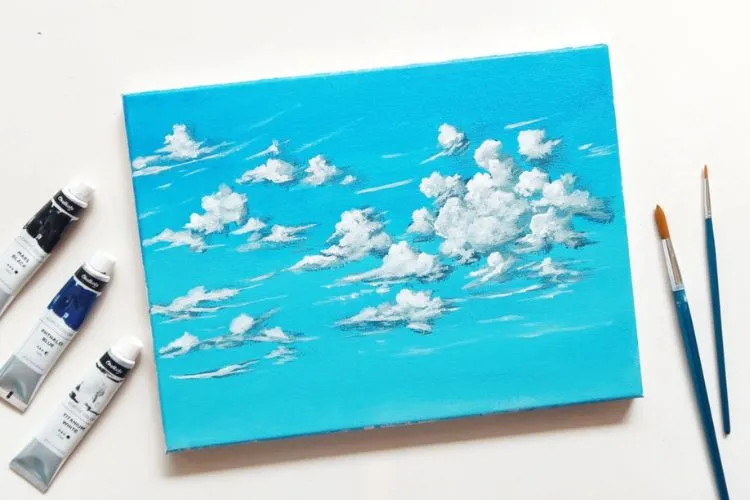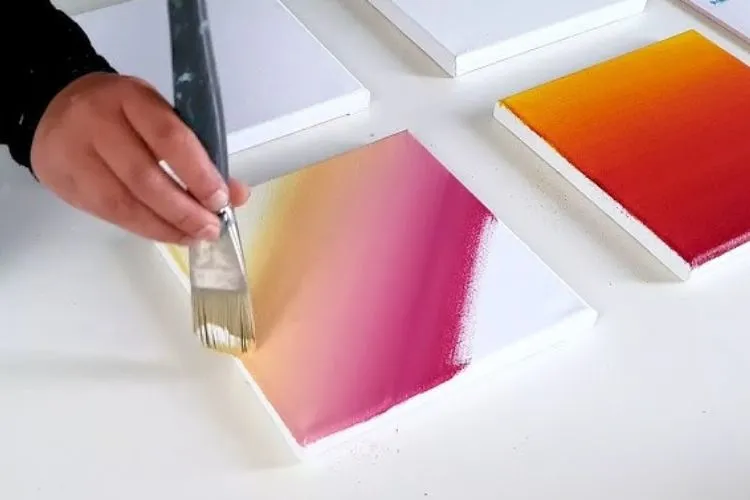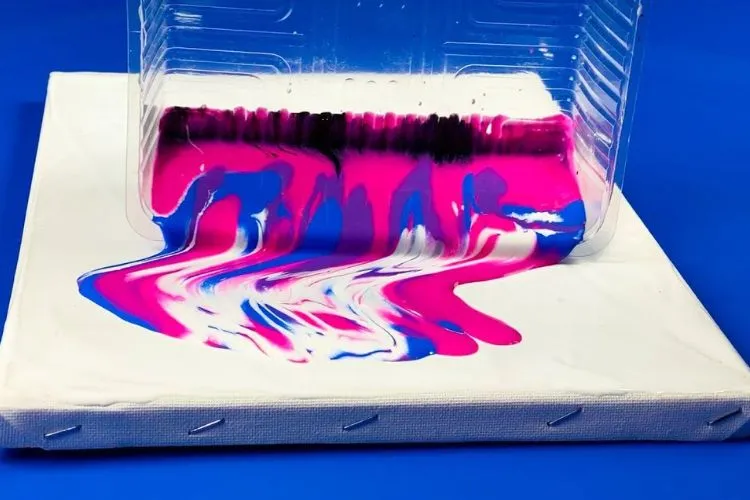Acrylic paint is a versatile medium that has become increasingly popular among artists of all levels.
Known for its vibrant colors, quick-drying properties, and versatility, acrylic paint offers a unique set of challenges and opportunities when it comes to blending. So, is acrylic paint easy to blend?
While some artists find it easier to blend than others, mastering the art of blending acrylic paint is achievable with the right techniques and understanding of the medium’s characteristics.

Is acrylic paint easy to blend?
Acrylic paint can be easy to blend, but it also presents some challenges due to its quick-drying nature. With the right techniques and tools, successful blending is achievable.
Key factors that affect blending acrylics include working swiftly before the paint dries, using mediums to extend the working time, and employing techniques like wet-on-wet blending, dry brush blending, and glazing.
Certainly! Here are the techniques mentioned, broken down in a simple and easy-to-understand way:
1. Working Swiftly Before the Paint Dries
- What It Means: Acrylic paint dries quickly. To blend different colors effectively, you need to paint fast.
- Simple Tip: Think of it as a race against time. Have your colors ready and plan what you want to blend before you start.
2. Using Mediums to Extend Working Time
- What It Means: Special liquids called “mediums” can be mixed with acrylic paints. These mediums slow down the drying time, giving you more time to blend.
- Simple Tip: It’s like adding a magic ingredient to your paint that lets you relax and blend colors without rushing.
3. Wet-on-Wet Blending
- What It Means: This technique involves adding a layer of paint directly on top of another layer that is still wet.
- Simple Tip: Imagine painting a sunset. While your yellow paint for the sun is still wet, add a bit of red to it. Gently mix them on the canvas where they meet to create a beautiful orange blend for the horizon.
4. Dry Brush Blending
- What It Means: Dry brush blending uses a brush that is relatively dry but still holds paint. It is lightly dragged across an area of dry paint, allowing the colors to mix on the surface.
- Simple Tip: It’s like using a magic wand. You lightly sweep a dry brush with a bit of paint over another color, and it creates a soft, textured blend. Perfect for creating the illusion of fur or grass.
5. Glazing
- What It Means: Glazing involves applying a thin, transparent layer of paint over a dry layer. This can change the color and tone underneath in subtle ways.
- Simple Tip: Think of it as putting on colored sunglasses. The world (or the paint beneath) looks different through the tint of the glasses (or the glaze). You can layer multiple “sunglasses” to get the effect you want.
By understanding and using these techniques, you can create beautiful and seamless blends with acrylic paints, even if it feels like a bit of a race against the clock sometimes!
Drying Time
One of the most significant factors that can affect the blending process of acrylic paint is its drying time. Unlike oil paints, which can remain workable for extended periods, acrylic paint dries relatively quickly.
It’s essential to understand that the drying time of acrylic paint can vary depending on factors such as the brand, the thickness of the application, and the environmental conditions (temperature, humidity, etc.).
As a general rule, acrylics can begin to dry within 10-20 minutes, making it crucial to plan your blending process accordingly.
Opacity and Consistency
Another characteristic of acrylic paint that can impact blending is its opacity and consistency. Acrylic paints are typically opaque, meaning they have a high pigment concentration and can cover underlying layers effectively.
This opaque nature can make blending more challenging, as it can be difficult to achieve smooth transitions between colors without leaving harsh edges or visible brushstrokes.
Additionally, the consistency of acrylic paint can vary depending on the brand, the amount of medium added, and the thickness of the application.
Some acrylic paints may have a thicker, more buttery consistency, while others may be thinner and more fluid. The consistency of the paint can affect how easily it blends and how smoothly the colors merge together.
You may also like to know: Does Acrylic Paint Dissolve in Water?
Techniques for Blending Acrylic Paint

Wet-on-Wet Blending
One of the most common and effective techniques for blending acrylic paint is wet-on-wet blending. This method involves blending colors while they are still wet, allowing them to merge seamlessly. To achieve successful wet-on-wet blending, it’s essential to work quickly and have a plan for the colors you want to blend.
Begin by applying a layer of paint in the area you want to blend. Then, without allowing the paint to dry completely, add the second color adjacent to or overlapping the first.
Using a clean, soft brush, gently blend the two colors together, working in a back-and-forth motion. The key to successful wet-on-wet blending is maintaining a consistent level of moisture in the paint, ensuring that it remains workable throughout the blending process.
To keep the paint workable for longer periods, consider using a stay-wet palette or spritzing water on the palette periodically. This will help prevent the paint from drying out too quickly, giving you more time to blend and achieve the desired effect.
Dry Brush Blending
Dry brush blending is another technique that can be particularly useful for softening edges and creating seamless transitions between colors in acrylic painting. This method involves using a dry brush with a minimal amount of paint to gently blend and feather the edges of existing paint layers.
Begin by applying your base colors or layers of paint, allowing them to dry completely. Then, load a clean, dry brush with a small amount of the color you want to blend. Using a light touch, gently brush over the edges of the existing paint, allowing the dry brush to pick up and blend the colors together.
The key to successful dry brush blending is controlling the amount of paint on the brush. Too much paint will result in harsh, visible brushstrokes, while too little paint will make it difficult to achieve the desired blending effect. Practice is essential to master this technique, as it requires a delicate touch and precise control over the amount of paint on the brush.
Glazing
Glazing is a powerful technique that can add depth and dimension to your acrylic paintings while also facilitating blending. This method involves applying transparent layers of paint over opaque layers, allowing the underlying colors to show through and creating a blended, luminous effect.
To glaze, begin by establishing your base layers of opaque color. Once these layers are dry, apply a thin, transparent layer of a different color over the top. This transparent layer, known as a glaze, will tint and blend the underlying colors, creating a new, mixed hue.
It’s important to use the right consistency of paint for glazing. Acrylics can be thinned with a glazing medium or fluid acrylics to achieve the desired transparency. Experiment with different ratios of paint to medium to find the perfect consistency for your desired effect.
Glazing can be particularly effective for creating depth and atmospheric effects in landscapes, as well as for blending skin tones and adding depth to portraiture.
Tools and Mediums for Blending
Brushes
The type of brushes you use can significantly impact your ability to blend acrylic paint effectively. While there is no one-size-fits-all brush for blending, certain brush types are better suited for this technique than others.
Soft synthetic brushes, such as those made from taklon or a synthetic squirrel hair blend, are excellent choices for blending acrylics.
These brushes have a smooth, flexible edge that can help create seamless transitions between colors. Additionally, fan brushes can be useful for blending large areas or creating soft, atmospheric effects.
When blending, it’s crucial to keep your brushes clean. Even a small amount of dried paint or debris on the brush can leave unwanted marks or textures in your blended areas. Be sure to clean your brushes thoroughly between color changes and after each blending session.
Mediums and Additives
While acrylic paint can be blended straight from the tube, the addition of mediums and additives can significantly enhance the blending process and provide greater control over the paint’s consistency and workability.
You can slow down the drying time of acrylic paint, giving you more time to blend and work with the colors. Flow improvers, on the other hand, can increase the paint’s fluidity, making it easier to blend and creating smoother transitions between colors.
Other mediums, such as glazing mediums or fluid acrylics, can be used to create transparent layers for glazing and blending techniques. Experimenting with different mediums and additives can help you find the perfect consistency and workability for your blending style.
Tips and Tricks for Successful Blending
Beyond the techniques and tools discussed above, there are several additional tips and tricks that can help you achieve successful blending with acrylic paint:

Work on a toned canvas: Instead of starting with a bright white canvas, consider toning it with a neutral color. This can help create a more harmonious base for your blending and make it easier to achieve smooth transitions between colors.
Blend in layers: Rather than trying to blend all colors at once, consider building up your blended areas in layers. This can provide greater control and allow you to adjust and refine the blending as you go.
Clean your palette regularly: A clean palette is essential for successful blending. Any dried or mixed paint on your palette can contaminate your colors and make it difficult to achieve accurate blending.
Experiment with different brushstrokes: Varying your brushstrokes can add depth and interest to your blended areas. Try using a combination of short, choppy strokes and long, sweeping movements to create dynamic blending effects.
Embrace imperfections: While smooth, seamless blending is often the goal, embracing the occasional imperfection or visible brushstroke can add character and interest to your work. Don’t be afraid to leave some areas slightly less blended for a more organic, painterly effect.
Frequently Asked Questions (FAQs)
Can you blend acrylic paint without mediums?
Yes, it is possible to blend acrylic paint without the use of mediums, though it can be more challenging. Blending straight from the tube requires working quickly before the paint dries and may result in more visible brushstrokes or texture.
How do you blend acrylic paint on canvas?
Blending acrylic paint on canvas follows the same principles as blending on other surfaces. Start by applying your base colors, then use techniques like wet-on
Conclusion:
It’s important to note that while water can be used to thin acrylic paint, it should be used judiciously, as too much water can compromise the integrity of the paint and lead to issues such as cracking or peeling over time.

Meet Isabella Anderson, your acrylic painting mentor with over a decade of brush-wielding mastery. Dive into the colorful world of acrylics with her expert guidance, featured exclusively on ‘Acrylic Authority.’ Unleash your inner artist and explore the limitless possibilities of this versatile medium alongside a true acrylic aficionado.
